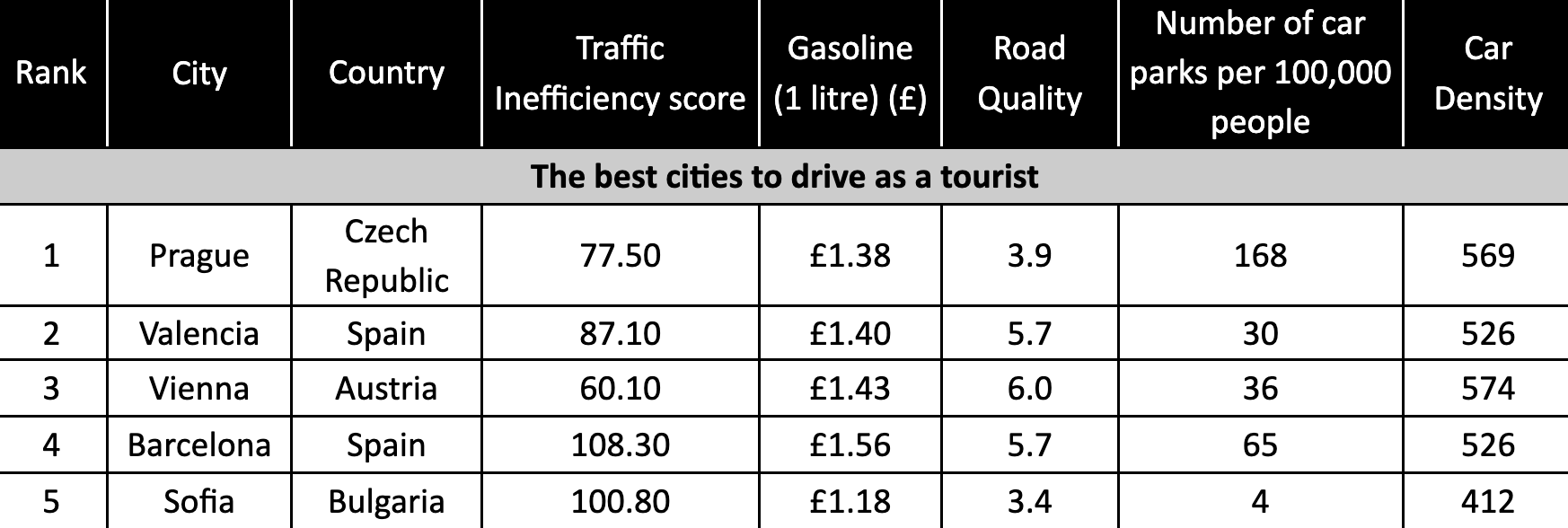
Top 10 Most Drivable Cities in Europe
Europe offers a rich tapestry of cultures, landscapes, and experiences, making it a popular destination for summer road trips.
Before you set out on your adventure, it's crucial to know which European cities offer the best driving experiences and which ones might pose challenges. The car insurance experts at Compare the Market have conducted extensive research to provide travelers with insights into the best and worst European cities to drive in during the summer months.
Prague, with its road quality score of 3.9 and traffic inefficiency score of 77.50, takes the crown as the best European city for summer driving. The city's efficient traffic flow and high-quality roads make it a delightful place for tourists to explore. Prague also boasts the highest number of car parks per 100,000 people (168), ensuring that finding a parking spot won't be a hassle as you discover its historical treasures.
Valencia, Spain, secures the second spot for its superb road quality, earning an overall score of 5.7 out of 7.0. The city's well-maintained roads contribute to a pleasant driving experience for travelers exploring this Spanish gem.
Vienna, Austria, stands out for having the lowest levels of traffic inefficiency (60.10) among the cities analyzed. Its road quality score of 6.0 out of 7.0 further cements its position as an excellent destination for summer driving.
Barcelona shares the second spot with Valencia, thanks to its high road quality score of 5.7 out of 7.0. The city's well-maintained roads make it a fantastic choice for travelers seeking a smooth driving experience.

Driving safely is crucial to protect yourself, your passengers, and others on the road. Here are some essential tips to help you drive safely:
1. Prepare Your Vehicle:
-
Ensure your vehicle is in good working condition by regularly checking the brakes, tires, lights, and fluid levels.
-
Keep your windshield and mirrors clean for optimal visibility.
2 Follow Traffic Rules:
-
Obey all traffic laws and regulations, including speed limits, stop signs, and traffic signals.
-
Use your seatbelt at all times, and make sure all passengers do the same.
3 Stay Alert:
-
Avoid driving when you're tired, drowsy, or under the influence of drugs or alcohol.
-
Get enough sleep before long trips, and take breaks to rest if necessary.
4. Avoid Distractions:
-
Keep your focus on the road and avoid distractions like texting, talking on the phone, eating, or adjusting the radio while driving.
-
Use hands-free devices if you need to make a call.
5. Maintain a Safe Following Distance:
Keep a safe distance from the vehicle in front of you to allow for reaction time and prevent rear-end collisions. The recommended following distance is at least 3-4 seconds.
6. Adjust to Weather Conditions:
-
Slow down in adverse weather conditions like rain, snow, or fog.
- Turn on your headlights in low-visibility conditions.
7. Use Turn Signals:
-
Indicate your intentions by using your turn signals before making a turn or changing lanes.
-
Check your blind spots before changing lanes.
8. Observe Speed Limits:
Drive at a safe and appropriate speed for the road conditions, which may be lower than the posted speed limit in some situations.
9. Be Mindful of Pedestrians and Cyclists:
-
Watch out for pedestrians at crosswalks and always yield the right-of-way.
-
Give cyclists enough space when passing them.
10. Adapt to Traffic Flow
-
Avoid aggressive driving behaviors such as tailgating, weaving between lanes, or road rage.
-
Be patient in traffic and try to maintain a consistent speed.
11. Use Proper Child Safety Seats:
Ensure that children are safely secured in age-appropriate car seats or booster seats.
12. Be Prepared for Emergencies:
Carry a roadside emergency kit, including items like a flashlight, jumper cables, and basic first aid supplies.
13. Stay Calm in Challenging Situations:
If you encounter aggressive or reckless drivers, do not engage with them. Instead, safely distance yourself from the situation and report it to the authorities if necessary.
14. Plan Your Route:
Before long trips, plan your route, and check traffic and weather conditions. Consider taking defensive driving courses or refresher courses to improve your driving skills.
Remember that safe driving is not just about following the rules; it's also about being considerate and aware of other road users. Defensive driving, anticipating the actions of others, and staying alert are key components of driving safely. Always prioritize safety over convenience or speed.
Trending
-
1 Jocko Willink's Inspirational Life & Net Worth
Aaqil Ashraf -
2 How Art Shapes Culture and Reflects Human Experience
Luke Fitzpatrick -
3 Meet Felix Williams and Maria Arthuer: The Parents of World Class Winger Nico Williams
Felix Yim -
4 Kai Cenat's Dad and the Enduring Public Interest
Aaqil Ashraf -
5 London Tube Stations Closed as Workers Stage Strikes
Mihir Gadhvi





Comments